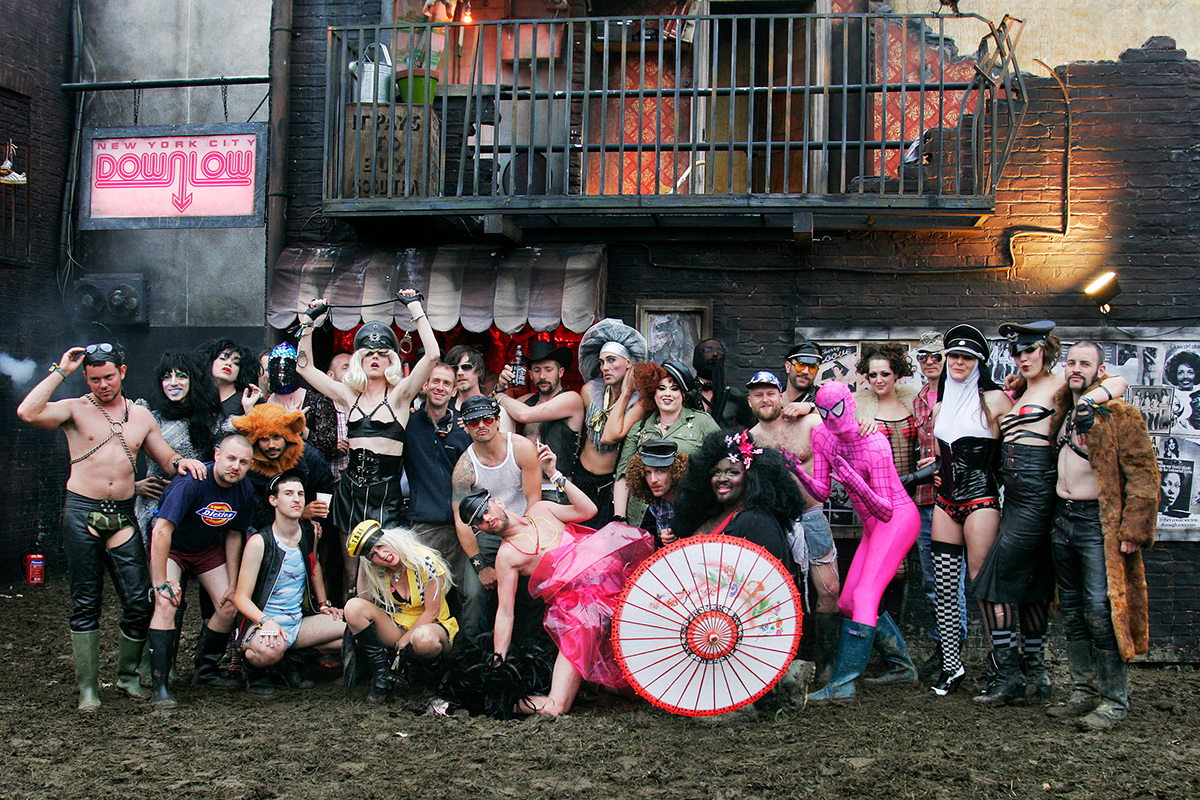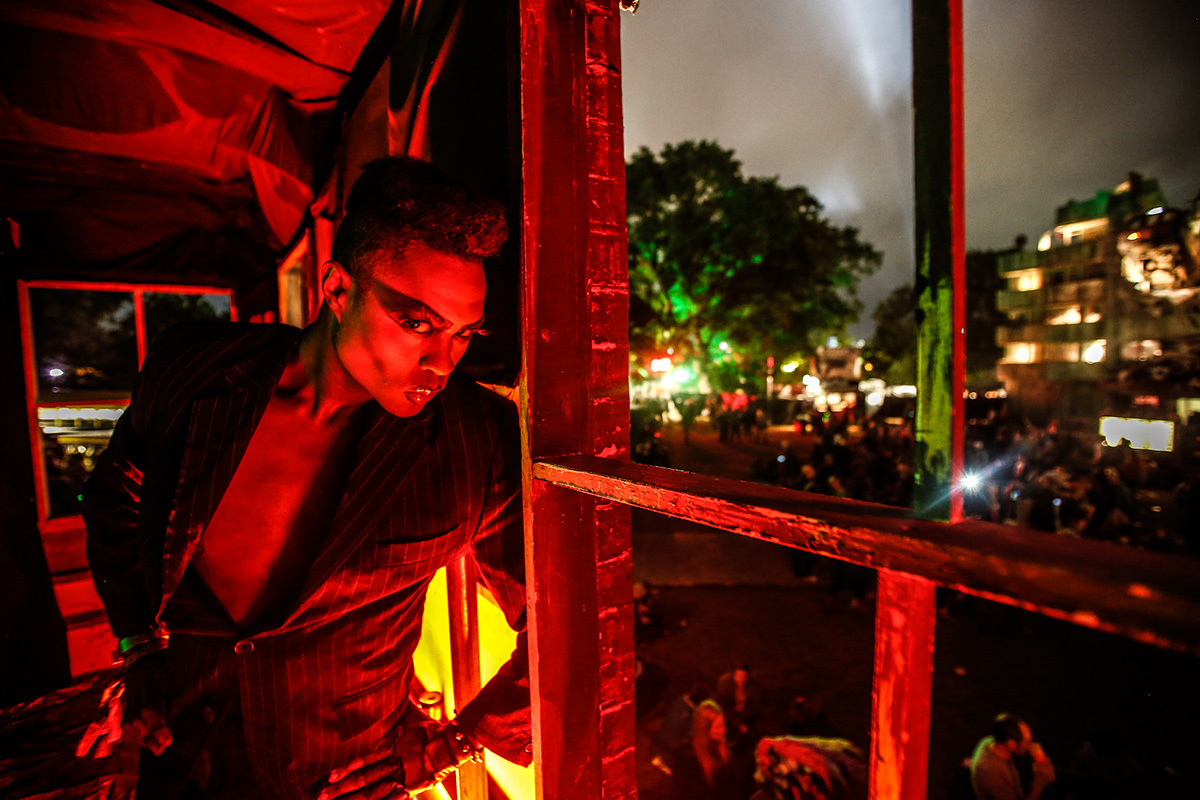In the deepest recesses of 2017’s Glastonbury, in the twilight shadows of Block 9, set designer Tony Hornecker erected The Church of St Corbyn’s and the Universicool of St Corbyn’s. Tony’s twin homage to faith and education rose above and watched over the wasted heat of Maceo’s, the 24-hour staff bar. Block 9 is Glastonbury’s homage to mirrorball nightlife in all its Dionysian excess. NYC Downlow, the festival’s peerless gay disco, is the twinkling diamond in its tiara. For Tony, a man whose artistic speciality is creating something out of nothing, seeing the beauty in others trash has brought a previously unseen ecclesiastical feel to proceedings. Up a mystery ladder to the Church of St Corbyn’s was an unattributed quote grafted to a side wall:
“The sweet summer of 2018. We did it dear children. We did it. Collectively we rose, our voices reached out and the redistribution began. The trickle now a steady stream, from the great heights a collective pool emerged and we comfortably bathed in its warm waters. The devil’s banished to the hills, past our open borders and beyond, sit cold and hungry exposed to the truths we laid bare. We made Britain great again. Not just for the few but for the many.”
In the Universicool of St Corbyn’s there was a library, kitted out with books for loan including Marxist Spencer’s Food Bank Recipes, Love in the Time of Co-opera, Fifty Shades of Red and Tory Mathematics. In front of both tiny school and church were makeshift gravestones for Boris Johnson, Amber Rudd and others for whom the spirit of kindness is professionally, politically and personally anathema. Amid this imaginative Dream-State sprung from his hands, Tony led some medical help in the form of the Gross Profit Hospital, where open your heart surgeries were offered and bleeding cuts stopped. Somewhere in the middle of Tony’s wonderful landscape rested the emotional spirit of the NYC Downlow, Glasto’s gay nightclub brim-full of possibility, in which a cascading new sense of freedom and personal liberation can begin to resemble reality.

In 2017, the Downlow celebrated its 10th birthday. In 2007, there was no specifically sequestered gay space at any mainstream British music festival. For Glastonbury, not just a space but an entire industry whose very ideology rests on its core liberal values, encouraging a British ecosystem in which complete equality is a winnable idyll, this not only felt outmoded, it felt positively Draconian.
NYC Downlow was the handiwork of Steve Gallagher and Gideon Berger. Steve and Gideon presented the idea for Glastonbury’s first gay club — one that would replicate in fine and detailed proximity a Manhattan discotheque from the golden age of gay clubbing — to Michael and Emily Eavis (the festival organisers) at their kitchen table. Their enterprising initiative was gold-sealed by the endorsement of the turntable wizards from Horse Meat Disco, then in the elemental stages of turning from a sophisticated Sunday evening Vauxhall social into a global brand.
The devil was all in the detail. Moustaches were distributed for charity at the door kiosk, free for anyone willing to reveal their manhood for bargain entry.
“I remember Gideon showing me the drawings and thinking ‘as if it’s ever going to look like that?'” says Horse Meat alumnus, walking disco encyclopaedia and one of the British DJ greats, Luke Howard. “Then I got there and thought, ‘wow, it looks even better than the drawings.'” The attention to detail in the sketches portrayed a loving approximation of the perfect imaginary night-time space. Brick-by-brick, Steve and Gideon built it. “From the very start we fell in love with it.”
That first early summer of 2007, it was clear that something had shifted in the Glastonbury ethos. On one level, it was the furtive secrecy of it all, something clandestine amid an increasingly over-exposed event that was now diarised and sold by the BBC. “The first year we were like an island in the middle of this lake of mud,” Luke recalls. “We were one of the few all-night venues and it became this thing – if you knew about it, you found it and you traipsed across the mud to find it.” On another, it was joyfully musical. “It was so great to have disco at a festival that had been dominated by rock and rave up until that point.” And for a third thumbs-up, the festival slowly shifted into a physically more curious and inclusive space. “Bringing that amount of queerness into what was traditionally a very heterosexual, even quite macho culture, was important. We brought campness, lightness, frivolity and fun, a different type of energy and people liked it because it was so irreverent.”
The Downlow imported its staff from the outer reaches of London nightlife and the free-party circuit. It hot-housed DJ names from the triumphant queer parties of San Francisco, Chicago, Berlin and New York, embracing their internationalism. Somebody once described the Downlow to me as being “like Studio 54 in a cow field”. The devil was all in the detail. Moustaches were distributed for charity at the door kiosk, free for anyone willing to reveal their manhood for bargain entry. In an age of stagnating celebrity, a new calibre of star was ignited at the door of the Downlow or dancing on the collapsing overhang of its terrace. The cast-list were demarked mostly by acid wit and a killer look, the perfect entrée to this new den of desire.

“I’d like to raise a plastic glass of warm Somerset plum wine to all those who made me crack up,” says regular door denizen Andy ‘Ma’ Butcher, who has looked after the shonky goings on there since the start. He singles out Manchester’s queen of the night Amber Swallows, vertiginous London cabaret starlets Jonny Woo and John Sizzle and “of course, the odd hot druid” for special mention.
The formulation of disco into the paradigms of festival culture reached a head ten years after the start of the Downlow. In 2017, a decade after disco first got greenlit at Glastonbury, Nile Rodgers’ indefatigable Chic Organisation entertained the masses and Barry Gibb finally acquiesced to slipping into a gold Saturday Night Fever jacket for his homage to his unprecedented family history, both on the Pyramid Stage.
In the staff bus on the way up to the site, the giants of disco’s past unknown offspring, the charming, talented and slightly demented new door kid Oozing Gloop was discussing the timing of Katy Perry’s divisive Glastonbury booking. In the end, Perry presented some ropey offcuts of Leigh Bowery’s best styling ideas, and a cheap replication of the sounds and moves Madonna and Prince both galvanised flawlessly through the 80s. But no one cared. Because that was daytime and – as the NYC Downlow merrily attests – all the sinful fun of Glastonbury and its glorious redemption is mostly to be found in the early hours of the morning.
The cowbells, the dance routines, the drag, the whole tempest will continue when Glastonbury returns in 2019. In many ways, it is now the jewel in the festival’s crown.
“It’s all a rollercoaster blur of excitement and amazing people,” says Andy Butcher, “a totally accepting community spirit, fostered by the Block 9 crew and extreme weather conditions, monsoon mud baths to sunstroke-inducing heatwaves.” His roster for Glastonbury has taken on pleasingly psychedelic dimensions. “Hours holed up in the porn kiosk just laughing with an endless parade of punters showing their floppies to jump the queue, inappropriate Shirley Bassey drag, Zoppy’s, our tent catching fire and sunrise at the stone circle with the gang.”
The NYC Downlow and its parent site kept on growing to full tumescence. Not that it’s all about penises (though quite a lot of it is). At one point in the mid-period of the Downlow, fine dining was introduced to Block 9. “Tony asked me to set up the Pale Blue Door at Glastonbury in 2010,” chef Elaine Chalmers says. “It was going to be called The Bordello, with a Love hotel above the restaurant.” Rooms were let out for a quickie by the hour. “When we arrived I checked out the cooking facilities. We had one four-ring electric cooker for a three course dinner, which we did every evening, fully booked, 60 covers each night. Only two rings on the cooker worked so it was like Challenge Anneka.” On the first night, the restaurant was rained out. The irrepressible A Man To Pet worked as maître d’. “As usual she was sliding up and down poles being the perfect hostess, but didn’t realise there was a baby in a pram on the floor and nearly sat on top of it.” That year, Elaine stayed in the Love hotel. “My friend Angela and I would sit on the balcony at different stages of the night watching the Downlow in full flow. It was just amazing.”

The cowbells, the dance routines, the drag, the whole tempest will continue when Glastonbury returns in 2019. In many ways, it is now the jewel in the festival’s crown. In the end, for the tenth anniversary of the NYC Downlow, Tony Hornecker’s quote on the wall of his church was not the only piece of writing to summarise the mass of heaving desire sweltering and dancing its way into the morning at the Downlow. The broken vintage Camel cigarettes ad that sits proudly atop the Meat Rack, the second disco palace of Block 9, features another inscription. “Try it,” the ad declares, over the image of a hunky, mustachioed man with a fag hanging out of his mouth. “You might like it.” And they do, every single year.
“It’s really helped to influence the way that festivals are run,” says Luke Howard, who has traditionally played the closing set of the Downlow each year. This year he followed Lil Louie Vega and Kenny Dope, the Masters At Work. “I think the demographic has changed quite a lot.” Progress at Glastonbury means progress for everyone. “People in their twenties don’t have the hang-ups that our generation had,” he adds. “They are much more accepting of gay people, of trans people.” Disco may yet be their most fitting soundtrack. “I try to play a lot of songs about love and togetherness and how important it is for everyone to be together and to feel loved and safe. I think that’s what the Downlow really represents: bringing people together, to be in that moment, in that spirit.” And a little bit more in love with life.
Credits
Text Paul Flynn
